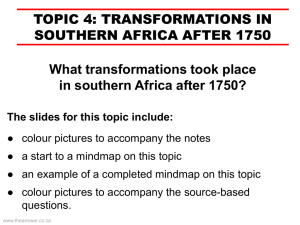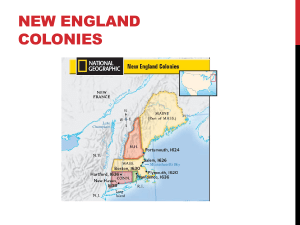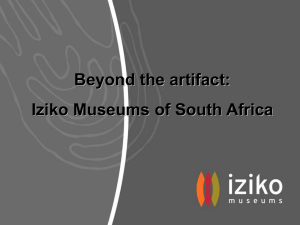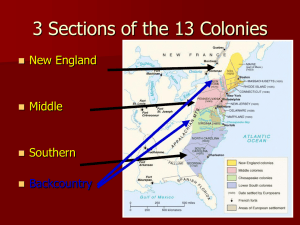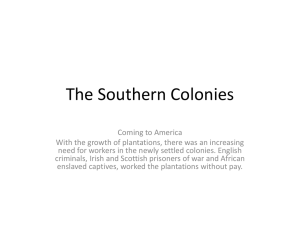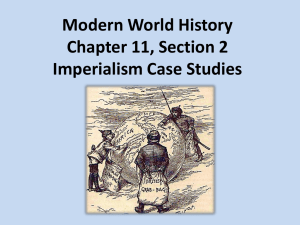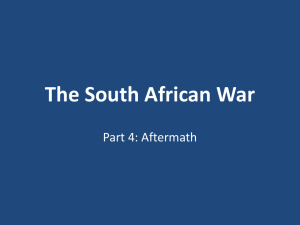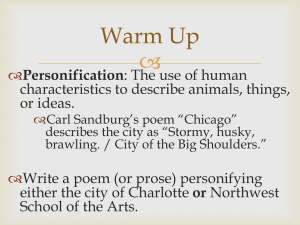History-Grade-10-Pics-for-Topic
advertisement
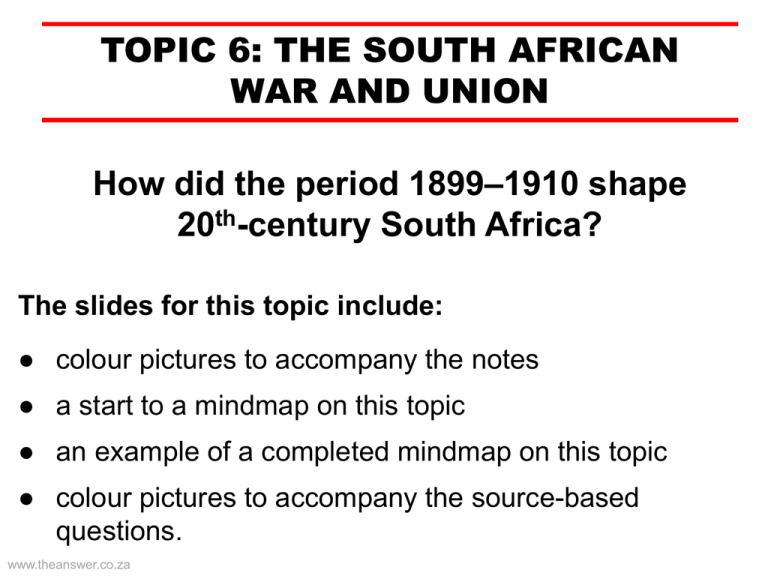
TOPIC 6: THE SOUTH AFRICAN
WAR AND UNION
How did the period 1899–1910 shape
20th-century South Africa?
The slides for this topic include:
● colour pictures to accompany the notes
● a start to a mindmap on this topic
● an example of a completed mindmap on this topic
● colour pictures to accompany the source-based
questions.
www.theanswer.co.za
www.theanswer.co.za
See page 121
Source: Africa through a Lens, part of the Colonial Office photographic
collection held at The National Archives: CO 1069/219
Paul Kruger
www.theanswer.co.za
See page 121
Source: Courtesy of the University of Texas Libraries, The University of Texas at Austin
Source: William Strang,1903, British Museum.
An etching of the
Right Honourable Joseph Chamberlain
www.theanswer.co.za
Randlords in the early days of
the Witwatersrand Gold Rush
See page 122
www.theanswer.co.za
Source: Paul Venter.
Source: African Library, Kimberley
The entrepreneur Barney Barnato made a
fortune in Kimberley buying old diamond
claims, mining them, and then selling them
to Rhodes. He then used the money to
invest in the Witwatersrand Gold Rush.
Sir Joseph Robinson
See page 122
Source: The British South Africa Company Historical Catalogue &
Souvenir of Rhodesia: Empire Exhibition, Johannesburg,
1936-37
THE FIRST BOARD OF DIRECTORS OF THE
BRITISH SOUTH AFRICA COMPANY, 1889
Top Row: Horace Farquhar, Esq.; Albert Grey, Esq.; Alfred Beit, Esq.
Middle Row: His Grace the Duke of Fife, K.T., P.C.; Hon. C. J. Rhodes
His Grace the Duke of Abercorn, K.G., P.C.
Bottom Row: Lord Grifford, V.C.; Herbert Canning, Esq.; George Cawston, Esq.
www.theanswer.co.za
See page 123
www.theanswer.co.za
Source: Rob Lavinsky / iRocks.com
Source: Africa Through a Lens
This picture of a stope in a Witwatersrand
mine shows the way that the gold-bearing
reefs are slanted.
A rich specimen of gold ore from the
current Witwatersrand mines. Here the
grains of gold are thickly dispersed
throughout a matrix of carbon-rich rock.
See page 124
Source: The National Archives UK / Africa through a Lens project
on Flickr: CO 1069-219-22
A traditional African homestead around the turn of the century
www.theanswer.co.za
See page 125
Source: Petit Parisien
An illustration from an 1896 Paris newspaper showing the arrest of Jameson
www.theanswer.co.za
See page 127
Jan Smuts in 1895
www.theanswer.co.za
See page 127
Source: Morne on http://af.wikipedia.org/wiki/L%C3%AAer:Jan_Smuts_1895.jpg
Source: The Diamonds of South Africa, Vol. II
The Long Cecil gun manufactured in the workshops of De Beers during the siege of Kimberley
www.theanswer.co.za
See page 128
Rhodesia
Portuguese
East Africa
Bechuanaland Protectorate
German SouthWest Africa
Mafikeng
Pretoria
Johannesburg
Orange Free State
Kimberley
Magersfontein
Bloemfontein
Basutoland
Protectorate
Swaziland
Natal Colony
Ladysmith
Colenso
Durban
Cape Colony
Cape Town
A map of southern Africa in 1900, showing Britain’s Cape Colony, the Basutoland Protectorate
(administered by the Cape Colony), Britain’s Natal Colony, the Orange Free State,
the South African Republic, and Swaziland (administered by the South African Republic),
as well as parts of German South-West Africa, Britain’s Bechuanaland Protectorate
and Rhodesia, and Portuguese East Africa
www.theanswer.co.za
See page 128
Boers at Spioenkop, 1900
www.theanswer.co.za
See page 128
Source: The Project Gutenberg EBook of With the Boer Forces,
by Howard C. Hillegas. 1900
Source: Courtesy of the Transvaal Archive
Organised by Mohandas Gandhi, the Indian Ambulance Corps helped wounded Brits
after many battles, including the Battle of Spioenkop.
www.theanswer.co.za
See page 128
Major General Baden-Powell and staff at Mafeking in 1900
www.theanswer.co.za
See page 129
Source: Photo by J. Angus Hamilton, Our Special Correspondent
with Major-General Baden-Powell
Source: The National Archives UK / Africa through a Lens project on Flickr:
CO 1069-219-38, with caption informed by Jon Hyslop
A cartoon showing President Paul Kruger fleeing into exile while British soldiers paint the
Orange Free State red, symbolising the victory of the British in the South African War
www.theanswer.co.za
See page 129
General Christiaan de Wet
www.theanswer.co.za
General Louis Botha
See page 130
Source: The Project Gutenberg EBook of With the Boer Forces,
by Howard C. Hillegas. 1900
Source: The Project Gutenberg EBook of With the Boer Forces,
by Howard C. Hillegas. 1900
Green Point Common in Cape Town was used as a transit
camp for prisoners of war to be shipped to remote islands.
www.theanswer.co.za
See page 130
Source: Henry Walter Barnett (1862–1934)
Emily Hobhouse, whose ashes are buried at the foot of the
1913 Women’s Memorial in Bloemfontein
www.theanswer.co.za
See page 131
Source: Africa Through a Lens
Bloemfontein Concentration Camp
www.theanswer.co.za
See page 131
Black men fought on both
sides of the war
A Black family in a concentration camp
www.theanswer.co.za
See page 132
Source: Weltrundschau zu Reclams Universum 1902
General Koos De la Rey is celebrated in the controversial song
De la Rey, most notably sung by Bok van Blerk in 2006
www.theanswer.co.za
See page 133
General Lord Herbert Kitchener
www.theanswer.co.za
Lord Alfred Milner
See page 133
Source: Henry Walter ('H. Walter') Barnett (1862-1934) / NPG
Source: Library of Congress Archives / Bain Collection
SourceJohanSteyn123 at en.wikipedia
The beginning of the Treaty of Vereeniging, signed
on 31 May 1902, at Melrose House, Pretoria
www.theanswer.co.za
See page 134
Mohandas Gandhi, who led a
protest against the Transvaal’s
Asiatic Registration Act of 1906
www.theanswer.co.za
John X. Merriman, Prime
Minister of the Cape Colony
from 1908 to 1910
See page 135
Source: Selections from the Correspondence of
Percy Molteno. VRS.
Source: http://armadillo.co.za/TimeTraveller/1906/
body.htm (cf. http://www.chem.yale.edu/
~chem125/125/history99/8Occult/Gandhi.html)
The delegation of prominent Cape politicians to protest against
the racist provisions of the draft South Africa Act, 4 August 1909
Seated from left are John Tengo Jabavu, A. Abdurahman, former Cape Prime Minister
William Schreiner, Walter Rubusana and Matt Fredericks. Standing at the back are
Thomas Makipela, J. Gerrans, Daniel Dwanya and D.J. Lenders.
www.theanswer.co.za
See page 135
www.theanswer.co.za
www.theanswer.co.za
The financial district of Johannesburg
www.theanswer.co.za
See page 136
Source: Africa Through a Lens / The National Archives UK – Flickr account
Source: Michael Barthop The Zulu War a pictorial history,
Blandford Press, UK 1980
A Boer house burning with all belongings strewn out front, circa 1901
www.theanswer.co.za
See page 137
Source: Caras y Caretas
The Boer High Command and the British High
Command meeting in 1901
www.theanswer.co.za
A cartoon in Die Amsterdamer
showing Kitchener saying to
Chamberlain, ‘Ah, now it is sharp
enough to butcher them’
See page 137
Source: SA government
The 1910 Union of South Africa Cabinet
www.theanswer.co.za
See page 138
The 1914 South African Native National Congress delegation to
London in 1914, with Sol Plaatje sitting at the front right
www.theanswer.co.za
See page 138
